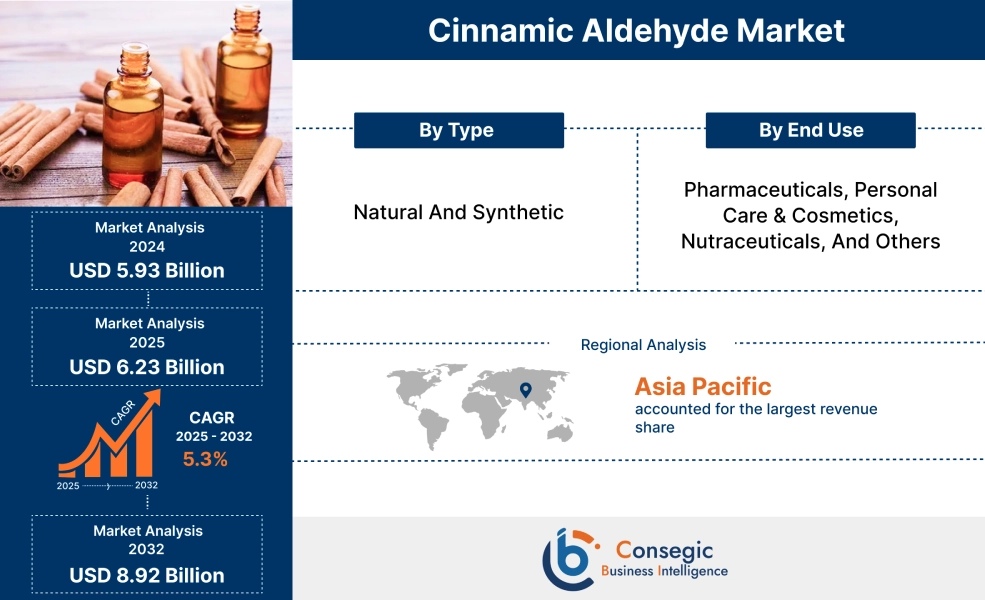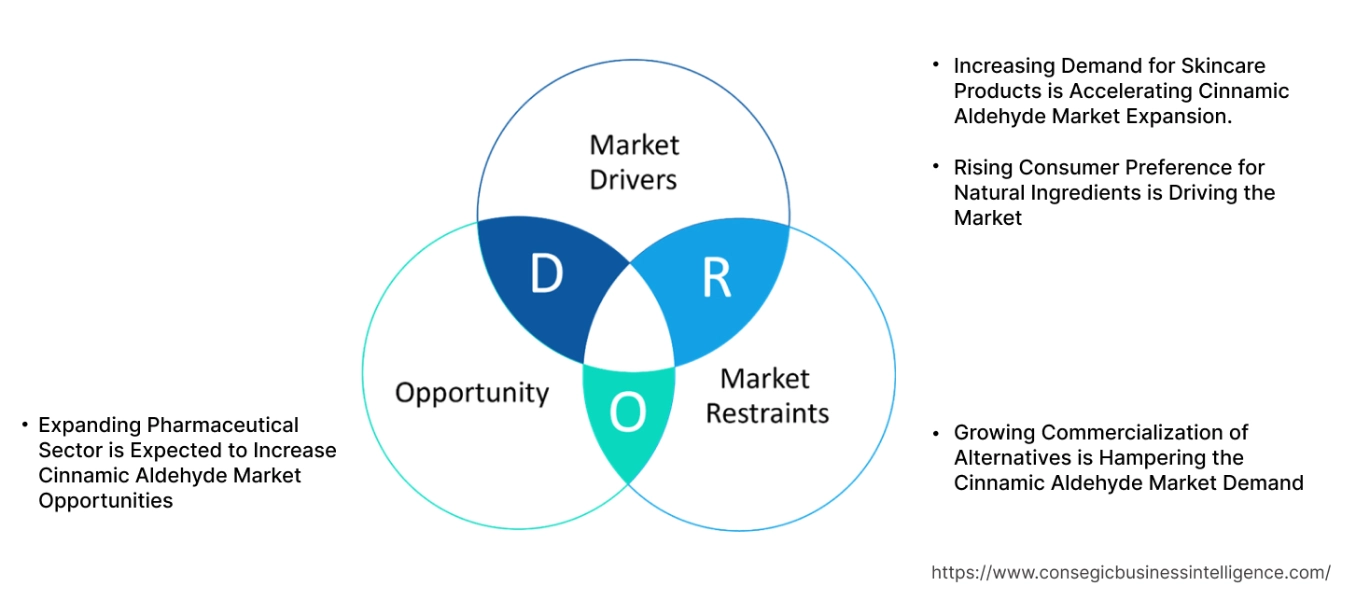Cinnamic Aldehyde Market Size:
Cinnamic Aldehyde Market size is growing with a CAGR of 5.3% during the forecast period (2025-2032), and the market is projected to be valued at USD 8.92 Billion by 2032 from USD 5.93 Billion in 2024. Additionally, the market value for the 2025 attributes to USD 6.23 Billion.
Cinnamic Aldehyde Market Scope & Overview:
Cinnamic aldehyde, also called cinnamaldehyde, is an organic compound. It is primarily manufactured by natural methods. This involves the extraction of essential oil from cinnamon bark through steam distillation. This oil is then further processed to isolate this compound. It is also prepared synthetically via the aldol condensation of benzaldehyde and acetaldehyde. It is a strong viscous liquid with a yellowish appearance. It has a strong, sweet, spicy, and woody cinnamon odor. Moreover, it is soluble in water but miscible with organic solvents such as ethanol and ether. It also exhibits good stability and chemical reactivity. This makes it useful as a flavoring, fragrance, antimicrobial, and corrosion inhibitor.
Cinnamic Aldehyde Market Dynamics - (DRO) :
Key Drivers:
Increasing Demand for Skincare Products is Accelerating Cinnamic Aldehyde Market Expansion.
Cinnamic aldehyde compound is used in skincare products for its distinct fragrance. It imparts a warm, spicy cinnamon scent to various luxury products. This includes lotions, creams, moisturizers, and other formulations. Moreover, it has Its natural ability to inhibit bacteria and fungi growth. This makes it useful as a preservative booster. Additionally, it has antioxidant properties, which protect the skin from radical and sun damage. Rising awareness of skincare routines and growing focus on self-care has led to an increased demand for skincare products, hence requiring this compound for multiple applications.
For instance,
- According to Cosmoprof, the sales of luxury skincare products in the U.S., increased by 18% in year 2021, when compared to 2020, thus positively impacting cinnamic aldehyde market trends.
Overall, the increasing demand for skincare products is significantly boosting the cinnamic aldehyde market expansion.
Rising Consumer Preference for Natural Ingredients is Driving the Market.
Cinnamic aldehyde compound is used to impart its warm, spicy cinnamon flavor in products such as chewing gum, candies, baked goods, desserts, ice cream, and beverages among others. Rising awareness of health risks associated with synthetic ingredients has led consumers to seek food products with natural ingredients (clean-label ingredients). This compound, when naturally extracted, provides high flavoring effects without exposing the human body to toxins. This clean-label trend is driving its usage for multiple applications.
For instance,
- Acosta Group’s Clean Label Insights Study conducted in 2024, revealed that a significant 81% of shoppers prioritize buying clean-label food products, thus positively impacting the cinnamic aldehyde market trends.
Thus, the rising consumer preference for natural ingredients is accelerating the global cinnamic aldehyde market growth.
Key Restraints:
Growing Commercialization of Alternatives is Hampering the Cinnamic Aldehyde Market Demand
The market faces competition from other substitutes available in the market. For instance, Eugenol (from clove oil), is beneficial in providing a warm, spicy aroma and flavor profile, similar to cinnamon. It also possesses strong antimicrobial and antioxidant properties. This makes it a versatile alternative, especially where a different spice profile is desired. Moreover, Methyl Cinnamate is another synthetic compound, which provides a sweet, fruity, balsamic, and slightly spicy aroma. It is used in flavors and fragrances to add warmth and depth. Hence, the growing commercialization of substitutes is hampering the cinnamic aldehyde market demand.
Future Opportunities :
Expanding Pharmaceutical Sector is Expected to Increase Cinnamic Aldehyde Market Opportunities
Cinnamic aldehyde has shown promising pharmacological effects. It has anti-inflammatory, anti-tumor, anti-bacterial, and neuroprotective properties. It's being researched by pharma manufacturers to use it in treating various diseases. This includes cancer, diabetes, and cardiovascular conditions. It also exhibits antimicrobial properties, including antifungal activity. Rising healthcare spending and advancements in drug development will lead to sector expansion, hence requiring this cinnamaldehyde for multiple applications.
For instance,
- According to IBEF, India's pharmaceutical industry is expected to grow at a CAGR of 10% from 2023 to 2030. This creates potential for the market.
Overall, expanding the pharmaceutical sector is expected to increase the cinnamic aldehyde market opportunities.
Cinnamic Aldehyde Market Segmental Analysis :
By Type:
Based on type, the market is categorized into natural and synthetic.
Trends in Type:
- Strong consumer preference for chemical-free ingredients is driving the usage of natural cinnamaldehyde in food, beverage, and personal care.
- There is a growing trend of using natural cinnamaldehyde beyond traditional flavor/fragrance. This includes pharmaceuticals and agriculture.
The natural segment accounted for the largest market share in 2024 and is expected to grow at the fastest CAGR over the forecast period.
- Natural cinnamaldehyde is derived from the essential oil of cinnamon bark. It is the component responsible for the distinctive cinnamon flavor and aroma.
- The natural type has a richer aromatic profile compared to its synthetic counterpart. This is due to the presence of other trace compounds from the natural source.
- Moreover, this type is perceived as safer and healthier by consumers. This boosts its market appeal, particularly in premium segments.
- Additionally, it is favored in regions with strict regulations regarding synthetic additives and where natural claims are highly valued.
- Due to its strong cinnamon flavor and natural source, it is used integrated into perfumes, soaps, lotions, oral care products, baked goods, beverages, dairy products, and confectionery. Growth in these industries is driving in currently and will also drive the segment share for the forecasted years.
- For instance, according to International Confectionery Magazine, the confectionery sector is expected to grow at a CAGR of 7.3% from 2023-2033.
- Overall, as per the market analysis, the aforementioned factors are driving a segment in the cinnamic aldehyde market growth.
By End Use:
Based on end-use, the market is categorized into personal care & cosmetics, food & beverage, consumer goods, pharmaceuticals, and others.
Trends in the End-Use
- Cinnamaldehyde's natural antimicrobial and antioxidant properties are leading to its incorporation into functional foods aimed at health-conscious consumers.
- There is a growing usage of cinnamaldehyde in fresheners and cleaning agents. It is due to its pleasant fragrance combined with antibacterial benefits.
The personal care & cosmetics segment accounted for the largest market share of 37.88% in 2024.
- Cinnamaldehyde provides a pleasant, natural-smelling scent to personal care and cosmetic products. This masks other less desirable odors from ingredients.
- It has the ability to inhibit bacteria and fungi. This contributes to the shelf life of products by preventing microbial contamination.
- Moreover, it has antioxidant effects. This helps protect the skin from free radical damage. Also, its anti-inflammatory properties soothe skin irritations.
- Consumers becoming aware of self-appearance has led to increased demand for these personal care and cosmetics products, hence driving the segment.
- For instance, according to theS. Bureau of Labor Statistics, in the U.S. consumer spending on personal care products increased by 9.7% in 2023 when compared to the previous year.
- Overall, as per the market analysis, the aforementioned factors are driving the segment in the cinnamic aldehyde industry.
The pharmaceuticals segment is expected to grow at the fastest CAGR over the forecast period.
- Cinnamic aldehyde is used as an active ingredient in formulations to combat bacterial and fungal infections.
- It has the potential to reduce inflammation and neutralize free radicals. This makes it a candidate for treatments targeting inflammatory disorders and oxidative stress-related conditions.
- Moreover, it improves gastrointestinal motility and offers anti-ulcer effects, particularly against Helicobacter pylori-induced gastritis.
- In oral pharmaceutical preparations such as syrups, lozenges, and throat sprays, it is used in low concentrations as a flavoring agent to mask the unpleasant taste of active pharmaceutical ingredients. All these benefits are driving its increased usage in the sector, hence driving the segment.
- Thus, according to cinnamic aldehyde market analysis, the aforementioned factors will drive segmental growth for the forecasted years.
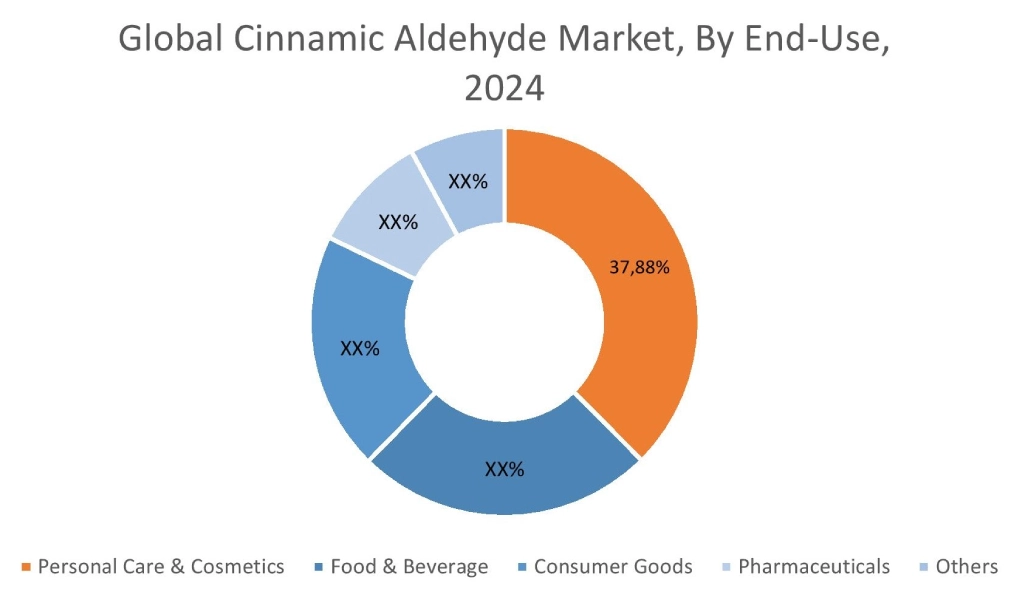
Regional Analysis:
The regional segment includes North America, Europe, Asia Pacific, the Middle East and Africa, and Latin America.
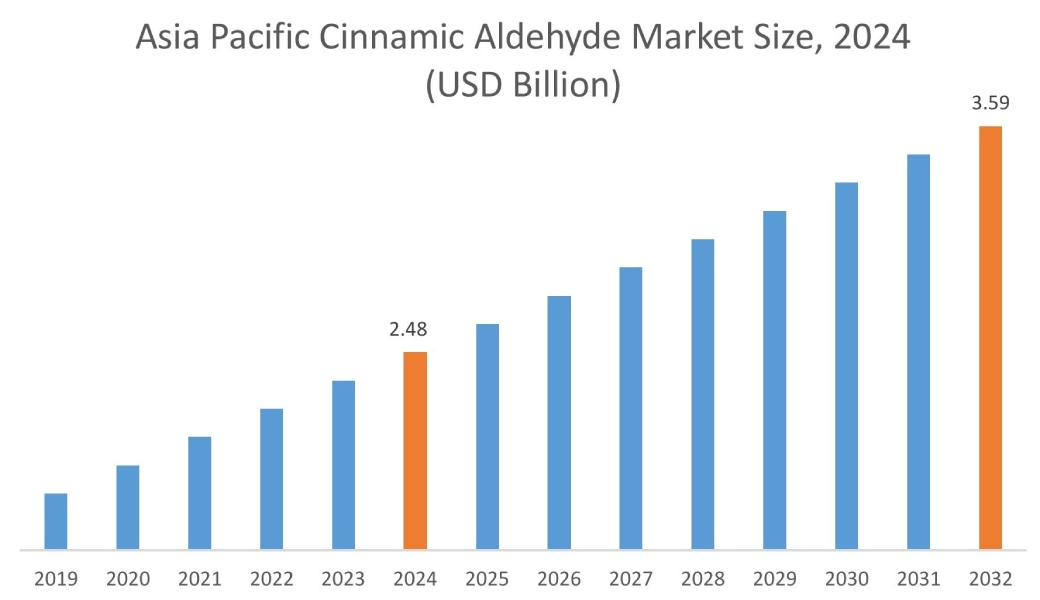
In 2024, Asia Pacific accounted for the highest cinnamic aldehyde market share at 41.77% and was valued at USD 2.48 Billion and is expected to reach USD 3.59 Billion in 2032. In Asia Pacific, the China accounted for the cinnamic aldehyde market share of 40.17% during the base year of 2024. The region’s personal care and cosmetics sector is increasing. This is fueled by rising disposable incomes, rapid urbanization, and a growing middle class. Consumers are increasingly investing in a wider range of beauty and personal grooming products.
For instance,
- According to Trendlyne, Lakme's, which is a beauty and cosmetic products manufacturer, saw a strong sales increase in the 2023 fiscal year, rising by 19.3% when compared to the previous year.
This directly translated to increased usage of cinnamaldehyde. It's highly valued for its distinctive, warm cinnamon fragrance in products such as perfumes, lotions, and soaps among others. Overall, the growing demand for personal care and cosmetic products is driving the market in the region.
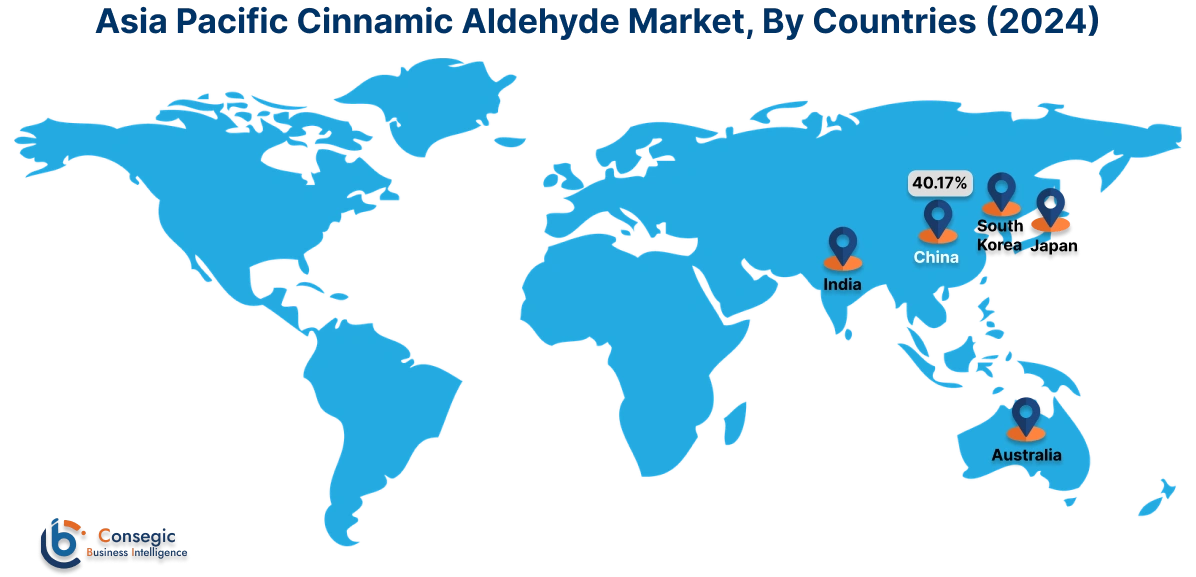
In Europe, the cinnamic aldehyde market is experiencing the fastest growth with a CAGR of 6.5% over the forecast period. There is robust pharmaceutical production in the region. This is driven by rising chronic disease, an aging population, technological advancements, and increasing healthcare spending. In this sector, cinnamaldehyde is used for its antimicrobial, antifungal, and anti-inflammatory properties. It has potential use in treating microbial infections and reducing inflammation-related conditions. Furthermore, it is used as a pharmaceutical intermediate in the synthesis of certain medications.
North America’s cinnamic aldehyde market analysis indicates that several key trends are contributing to its growth in the region. It is fueled by the expanding use in the food and beverage industry. Consumers in the region are increasingly seeking diverse flavor options. This makes cinnamaldehyde an attractive ingredient. It is widely utilized for its distinctive sweet and spicy cinnamon flavor in a variety of applications. This includes confectionery, baked goods, beverages, and chewing gums. Moreover, its antimicrobial properties make it valuable as a food preservative, enhancing shelf life.
Middle East and Africa (MEA) market analysis indicates that there is increasing usage of consumer goods in the region. As disposable incomes rise and urbanization continues across the region, there is a growing need for a diverse range of household products. This trend is also driven by a rising emphasis on hygiene and cleanliness across the region. Cinnamic aldehyde is used in products such as air fresheners, detergents, and surface cleaners due to its fragrance and antimicrobial properties.
Latin America's region creates potential as the market is significantly boosted by the accelerating clean label trend. Analysis states that countries such as Brazil and Chile lead the market. Consumers across the region are actively seeking products with natural ingredients, which are free from artificial additives and synthetic chemicals. Cinnamaldehyde, derived naturally from cinnamon, aligns with this consumer preference. It is used as a natural flavoring agent in food and beverage processing. As a clean ingredient, it is increasingly used in personal care products.
Top Key Players and Market Share Insights:
The Cinnamic Aldehyde market is highly competitive with major players providing products to the national and international markets. Key players are adopting several strategies in research and development (R&D) and product innovation to hold a strong position in the global Cinnamic Aldehyde market. Key players in The Cinnamic Aldehyde industry include-
- LANXESS AG (Germany)
- Fengchen Group Co., Ltd (China)
- Vdh Organics Pvt. Ltd (India)
- American Molecules (United States)
- Aadhunik Industries (India)
- CDH Fine Chemical (India)
- MP Biomedicals (United States)
- Muby Chemicals (India)
- Merck KGaA (Germany)
- Kao Corporation (Japan)
Cinnamic Aldehyde Market Report Insights :
| Report Attributes | Report Details |
| Study Timeline | 2019-2032 |
| Market Size in 2032 | USD 8.92 Billion |
| CAGR (2025-2032) | 5.3% |
| By Type |
|
| By End-Use |
|
| By Region |
|
| Key Players |
|
| North America | U.S. Canada Mexico |
| Europe | U.K. Germany France Spain Italy Russia Benelux Rest of Europe |
| APAC | China South Korea Japan India Australia ASEAN Rest of Asia-Pacific |
| Middle East and Africa | GCC Turkey South Africa Rest of MEA |
| LATAM | Brazil Argentina Chile Rest of LATAM |
| Report Coverage |
|
Key Questions Answered in the Report
How big is the Cinnamic Aldehyde market? +
In 2024, the Cinnamic Aldehyde market is USD 5.93 Billion.
Which is the fastest-growing region in the Cinnamic Aldehyde market? +
Europe is the fastest-growing region in the Cinnamic Aldehyde market.
What specific segmentation details are covered in the Cinnamic Aldehyde market? +
Type and End-Use segmentation details are covered in the Cinnamic Aldehyde market.
Who are the major players in the Cinnamic Aldehyde market? +
LANXESS AG (Germany), CDH Fine Chemical (India), MP Biomedicals (United States), Muby Chemicals (India), Merck KGaA (Germany), and Kao Corporation (Japan) are some major players in the market.
